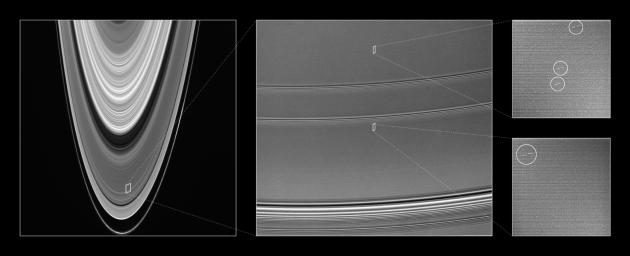
|
Locating the Propellers
- Click the image above for a larger view
- Full-Res JPEG (3168 x 1288) (442.0 kB)
- Full-Res TIFF (3168 x 1288) (4.1 MB)
Caption:
This collection of Cassini images provides context for understanding the location and scale of propeller-shaped features observed within Saturn's A ring.
Careful analysis of the highest resolution images taken by Cassini's cameras as the spacecraft slipped into Saturn orbit revealed the four faint, propeller-shaped double-streaks in an otherwise bland part of the mid-A ring. Imaging scientists believe the "propellers" provide the first direct observation of the dynamical effects of moonlets approximately 100 meters (300 feet) in diameter. The propeller moonlets represent a hitherto unseen size-class of particles orbiting within the rings.
The left-hand panel provides broad context within the rings, and shows the B ring, Cassini Division, A ring and F ring. Image scale in the radial, or outward from Saturn, direction is about 45 kilometers (28 miles) per pixel; because the rings are viewed at an angle, the image scale in the longitudinal, or circumferential, direction is several times greater.
The center image is a closer view of the A ring, showing the radial locations where propeller features were spotted. The view is approximately 1,800 kilometers (1,100 miles) across from top to bottom and includes a large density wave at bottom (caused by the moons Janus and Epimetheus), as well as two smaller density waves. The footprints of the propeller discovery images are between density waves, in bland, quiescent regions of the ring.
The propellers appear as double dashes in the two close-up discovery images at the right and are circled. The unseen moonlets, each roughly the size of a football field, lie in the center of each structure. These two images were taken during Saturn orbit insertion on July 1, 2004, and are presented here at one-half scale. Resolution in the original images was 52 meters (171 feet) per pixel. The horizontal lines in the image represent electronic noise and do not correspond to ring features.
The propellers are about 5 kilometers (3 miles) long from tip to tip, and the radial offset (the "leading" dash is slightly closer to Saturn) is about 300 meters (1,000 feet).
The propeller structures are unchanged as they orbit the planet. In that way, they are much like the wave pattern that trails after a speedboat as it skims across a smooth lake. Such a pattern is hard to discern in a choppy sea. In much the same way, scientists think other effects may be preventing Cassini from seeing the propellers except in very bland parts of the rings.
See PIA07790 and PIA07791 for additional images showing these features.
Background Info:
The Cassini-Huygens mission is a cooperative project of NASA, the European Space Agency and the Italian Space Agency. The Jet Propulsion Laboratory, a division of the California Institute of Technology in Pasadena, manages the mission for NASA's Science Mission Directorate, Washington, D.C. The Cassini orbiter and its two onboard cameras were designed, developed and assembled at JPL. The imaging operations center is based at the Space Science Institute in Boulder, Colo.
For more information about the Cassini-Huygens mission visit http://saturn.jpl.nasa.gov/home/index.cfm . The Cassini imaging team homepage is at http://ciclops.org .
Cataloging Keywords:
| Name | Value | Additional Values |
|---|---|---|
| Target | Saturn Rings | A Ring, Cassini Division, Epimetheus, Janus, Saturn |
| System | Saturn | |
| Target Type | Ring | Gap, Planet, Satellite |
| Mission | Cassini-Huygens | |
| Instrument Host | Cassini Orbiter | |
| Host Type | Orbiter | |
| Instrument | Imaging Science Subsystem (ISS) | |
| Detector | ||
| Extra Keywords | Grayscale, Moonlet, Propeller, Wave | |
| Acquisition Date | ||
| Release Date | 2006-03-29 | |
| Date in Caption | 2004-07-01 | |
| Image Credit | NASA/JPL/Space Science Institute | |
| Source | photojournal.jpl.nasa.gov/catalog/PIA07792 | |
| Identifier | PIA07792 | |
